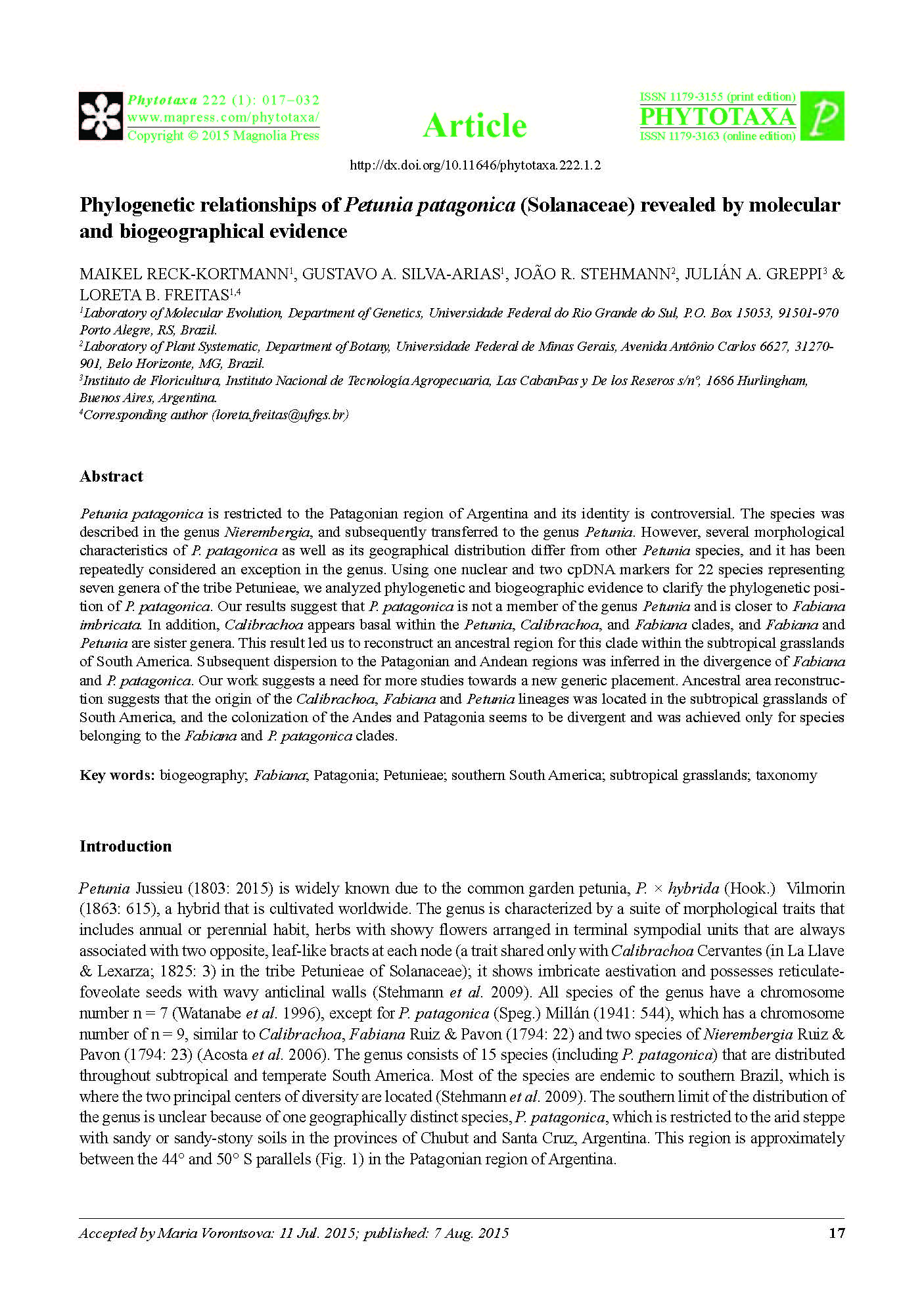Ver ítem
- xmlui.general.dspace_homeCentros e Institutos de InvestigaciónCIRN. Centro de Investigaciones de Recursos NaturalesInstituto de FloriculturaArtículos científicosxmlui.ArtifactBrowser.ItemViewer.trail
- Inicio
- Centros e Institutos de Investigación
- CIRN. Centro de Investigaciones de Recursos Naturales
- Instituto de Floricultura
- Artículos científicos
- Ver ítem
Phylogenetic relationships of Petunia patagonica (Solanaceae) revealed by molecular and biogeographical evidence
Resumen
Petunia patagonica is restricted to the Patagonian region of Argentina and its identity is controversial. The species was
described in the genus Nierembergia, and subsequently transferred to the genus Petunia. However, several morphological
characteristics of P. patagonica as well as its geographical distribution differ from other Petunia species, and it has been
repeatedly considered an exception in the genus. Using one nuclear and two cpDNA markers
[ver mas...]
Petunia patagonica is restricted to the Patagonian region of Argentina and its identity is controversial. The species was
described in the genus Nierembergia, and subsequently transferred to the genus Petunia. However, several morphological
characteristics of P. patagonica as well as its geographical distribution differ from other Petunia species, and it has been
repeatedly considered an exception in the genus. Using one nuclear and two cpDNA markers for 22 species representing
seven genera of the tribe Petunieae, we analyzed phylogenetic and biogeographic evidence to clarify the phylogenetic position
of P. patagonica. Our results suggest that P. patagonica is not a member of the genus Petunia and is closer to Fabiana
imbricata. In addition, Calibrachoa appears basal within the Petunia, Calibrachoa, and Fabiana clades, and Fabiana and
Petunia are sister genera. This result led us to reconstruct an ancestral region for this clade within the subtropical grasslands
of South America. Subsequent dispersion to the Patagonian and Andean regions was inferred in the divergence of Fabiana
and P. patagonica. Our work suggests a need for more studies towards a new generic placement. Ancestral area reconstruction
suggests that the origin of the Calibrachoa, Fabiana and Petunia lineages was located in the subtropical grasslands of
South America, and the colonization of the Andes and Patagonia seems to be divergent and was achieved only for species
belonging to the Fabiana and P. patagonica clades.
[Cerrar]

Autor
Reck-Kortmann, Maikel;
Silva-Arias, Gustavo A.;
Stehmann, João R.;
Greppi, Julian Alejandro;
Freitas, Loreta B.;
Fuente
Phytotaxa 222 (1) : 017–032. (2015)
Fecha
2015
ISSN
1179-3155
1179-3163 (Online)
1179-3163 (Online)
Formato
pdf
Tipo de documento
artículo
Palabras Claves
Derechos de acceso
Restringido
 Excepto donde se diga explicitamente, este item se publica bajo la siguiente descripción: Creative Commons Attribution-NonCommercial-ShareAlike 2.5 Unported (CC BY-NC-SA 2.5)
Excepto donde se diga explicitamente, este item se publica bajo la siguiente descripción: Creative Commons Attribution-NonCommercial-ShareAlike 2.5 Unported (CC BY-NC-SA 2.5)

